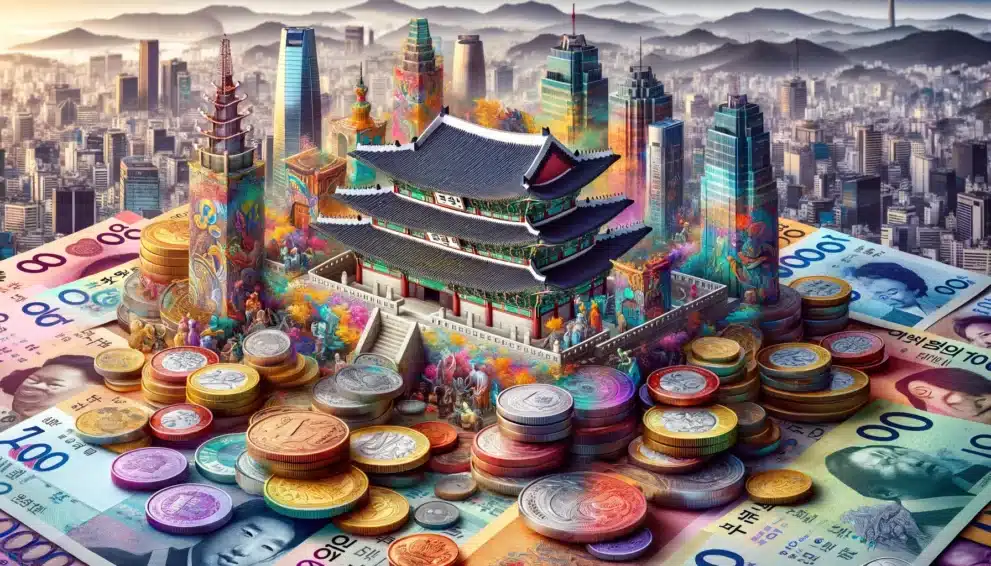
The “won” is the official currency of South Korea, represented by the symbol ₩ and the ISO code KRW (Korean Republic Won). It is used in South Korea and comes in both coin and banknote forms. The won is subdivided into 100 jeon, the latter being a unit of currency that is no longer used for everyday transactions and only appears in foreign exchange rates. The won is worth much less than the U.S. dollar. For example, 300 million WON to USD is just $300,000 USD.
The South Korean won was first introduced in 1945, replacing the Korean yen that was in use during Japan’s occupation of Korea. The currency has undergone several significant changes and revaluations since then. After the Korean War, South Korea established a new won currency in 1962 to stabilize its economy and simplify transactions. The currency has been modernized over the years, with various series of banknotes and coins introduced to reflect South Korea’s economic growth, culture, and history.
Today, the won is a key currency in the global foreign exchange markets and plays a vital role in South Korea’s dynamic economy, which is one of the largest in Asia and the world. South Korea’s central bank, the Bank of Korea, is responsible for issuing and managing the won, including monetary policy to ensure stability and economic growth.
The history of the South Korean won is a narrative deeply intertwined with the country’s tumultuous 20th-century experiences, marked by colonization, war, and rapid economic development. Introduced in 1945, the won replaced the Korean yen at par as Japan’s 35-year colonial rule over the Korean Peninsula came to an end. This initial version of the won was short-lived, however, as the Korean War and the subsequent division of Korea led to the creation of two distinct currencies for the two Koreas in 1947.
In the years following the Korean War, South Korea faced significant economic challenges, including high inflation and a complex currency system that hindered economic progress. To address these issues, the South Korean government undertook a currency reform in 1953, which led to the introduction of the hwan at a rate of 1 hwan to 100 won. However, the hwan also fell victim to inflation, prompting the South Korean government to reintroduce the won in 1962 at a rate of 1 won to 10 hwan, establishing the second and current version of the South Korean won.
This revaluation was part of broader economic reforms aimed at stabilizing the South Korean economy and laying the groundwork for future growth. The reintroduction of the won coincided with South Korea’s rapid industrialization and economic development, known as the Miracle on the Han River, which transformed the country into one of the world’s leading economies.
Throughout its history, the won has undergone numerous redesigns in both its coins and banknotes to modernize its appearance, improve security features, and reflect South Korea’s cultural heritage and economic achievements. Today, the won is not only a symbol of South Korea’s economic resilience and prosperity but also an essential tool in the country’s ongoing participation in global trade and finance. Managed by the Bank of Korea, the won continues to play a critical role in the country’s economy, adapting to the challenges and opportunities of the 21st century.
Won and hwan
The terms “won” and “hwan” refer to two different currencies used in South Korea at different times in its modern history, reflecting periods of economic transition and development.
The won was first introduced in 1945, following the liberation of Korea from Japanese occupation. It replaced the Korean yen that was in use during the colonial period. The won was initially pegged to the United States dollar at a rate of 15 won to 1 dollar. However, due to the Korean War (1950-1953) and the resulting economic turmoil, the won experienced severe inflation.
To stabilize the economy and address the inflation issue, South Korea underwent a currency reform in 1953, which led to the introduction of the hwan. The hwan replaced the won at a rate of 1 hwan to 100 won. This was an attempt by the South Korean government to curb inflation and simplify the currency system. However, the hwan itself became subject to inflation, leading to another currency reform.
In 1962, South Korea reintroduced the won, this time replacing the hwan at a rate of 10 hwan to 1 won. This reintroduction was part of a broader set of economic measures aimed at stabilizing the economy and fostering rapid economic development. Since then, the won (KRW, Korean Republic Won) has remained South Korea’s official currency.
The use of both terms, won and hwan, at different times in South Korea’s history reflects the country’s efforts to establish a stable and robust economic system amidst the challenges of post-war reconstruction, inflation, and the pursuit of economic growth.




 Share
Share Tweet
Tweet Share
Share




Comment